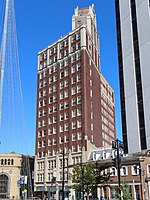English Evangelical Church of the Reformation and Parish House

Lutheran Church of the Reformation, also known as Glory House International, is a historic church complex located at Rochester in Monroe County, New York. It was built in 1900–1902, and is a Late Romanesque Revival style sandy grey brick church with stone embellishments. It features two flanking towers of differing sizes on the main facade, round arched windows, corbel tables and stone window tracery. The larger tower has a steeply pitched pyramidal roof. Attached to the church by a hyphen is a three-story, less elaborate brick dependency.: 14 It was listed on the National Register of Historic Places in 1992. In 2022, Reformation Lutheran Church merged with another Lutheran church and its building was purchased by Glory House International, a non-denominational African American congregation.
Excerpt from the Wikipedia article English Evangelical Church of the Reformation and Parish House (License: CC BY-SA 3.0, Authors, Images).English Evangelical Church of the Reformation and Parish House
Stillson Street, City of Rochester
Geographical coordinates (GPS) Address Nearby Places Show on map
Geographical coordinates (GPS)
| Latitude | Longitude |
|---|---|
| N 43.158888888889 ° | E -77.603333333333 ° |
Address
Stillson Street
14604 City of Rochester
New York, United States
Open on Google Maps










